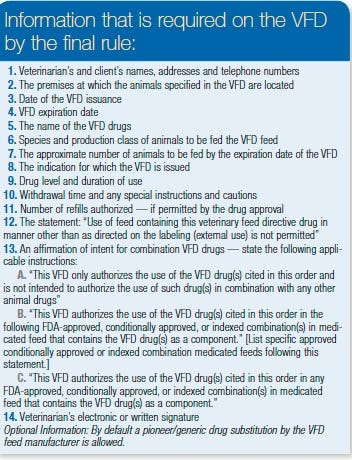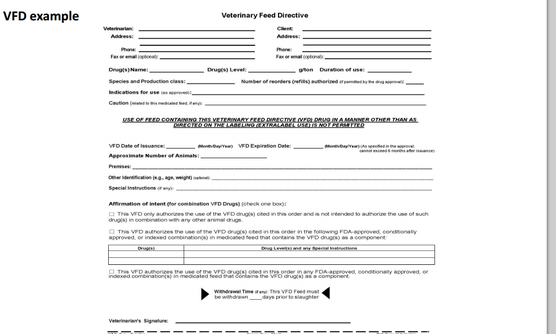The days of simply picking up an antimicrobial to be used in the feed or water will soon be gone

The way antibiotics are used on the farm will soon be changing, and during this transition period, hog farmers are encouraged to prepare for the adjustment. Jennifer Koeman, DVM, director of producer and public health for the National Pork Board, says, “Antibiotics aren’t going away, but on-farm use will change. Producers should sit down with their veterinarians to discuss how to apply veterinary feed directives and other herd-health strategies.”
In 2012, the U.S. Food and Drug Administration began the regulatory journey to eliminate the use of antimicrobials that are medically important to human illness for growth promotion and bring veterinary oversight to therapeutic use to treat, control or prevent diseases. Officially, the FDA issued the proposal for the Veterinary Feed Directive final rule on antibiotic use in June. The VFD final rule is the third leg in the regulatory journey, following the release of Guidance for Industry 209 and 213.
What is changing
Basically, this regulatory process is about modifying the way feed- and water-based antimicrobials are utilized in animal production. For producers the regulatory change will result in the removal of some antibiotic products or eliminate growth promotion use of the antibiotics. Growth promotion and nutritional efficiency labels on medically important antibiotics will be removed by December 2016. During this transition time, the FDA is working with animal health sponsors to cease claims on antimicrobial products labeled for growth promotion or migrate the production claim to disease prevention.
At this point all animal health sponsors have agreed to voluntarily surrender their approval for growth promotions and move remaining therapeutic uses under VFD or prescription for affected products, Koeman explains. Once the labels are changed, it will be illegal to utilize these antibiotics to promote growth, and producers will need a veterinarian’s oversight to use these products in the feed or water for therapeutic use.
In general, she says the majority of antibiotics used in animal feed for pork production are medically important, with the exception of bacitracin, mecadox, narasin, bambermycin and tiamulin. After this regulatory change, 283 products labeled for all species will be added to the VFD list. To date, bacitracin, mecadox, narasin, bambermycin and tiamulin are the only antimicrobials that will remain available to purchase over the counter for growth promotion. All other swine antibiotics used for disease prevention, control and treatment used in the feed will require VFD or a veterinarian prescription for use in water.
The VFD rule goes into effect on Oct. 1, 2015 and any feed manufacturers using a drug with a VFD label must comply with the new rule upon that date. Animal health sponsors have until December 2016 to transition drug products to VFD and change the label accordingly.
Overall, everyone wants antibiotics to work effectively for both humans and pigs. The purpose of this regulatory change is to ensure the ongoing judicious use of antibiotics, not to reduce the amount of antimicrobials on the farm.
Harry Snelson, DVM and director of communications for the American Association of Swine Veterinarians, says the main reason for changing the VFD process is not to adequately quantify the amount of antimicrobial use in animal production on the farm. Volume of use does not have anything to do with the antibiotic resistance issue. The issue with resistance is that bug-drug interaction at the individual pig level. He explains, “That on-farm data may help us better understand what practices occurring on the farm may actually contribute to resistance down the road. Those practices we may need to modify.”
Farm preparedness
The days of simply picking up an antimicrobial to be used in the feed or water will soon be gone. The relationship between the veterinarian and the producer on the farm will become more critical for access to antimicrobials that were previously purchased over the counter, Snelson states.
The good news for swine producers is the VFD process is not foreign territory. The swine industry has worked with VFD drugs since the introduction of Pulmotil — the first VFD-labeled drug. Moreover, the Pork Quality Assurance Plus program has already established a solid educational foundation centered on fostering veterinarian-client-patient relationships and judicious use of antibiotics.
Although the final implementation date of December 2016 seems a long way off, hog farmers should get the preparation wheels turning now. The first step is to secure a good working relationship with your herd veterinarian. It is important to utilize a veterinarian who is familiar with your production system and has a full understanding of the VFD process.
Snelson recommends sitting down with your veterinarian and thoroughly evaluating all animal health management protocols, including herd vaccination programs. Together, establish a strategy to minimize disease risk through facility design, pig flows, vaccination procedures, monitoring herd health, disease surveillance and appropriate diagnostics. Prevention is a better alternative to using antimicrobials later for treatment.
On a regular basis, producers should review all current swine medications being used on the farm with a veterinarian. Once a product is used, it is important to determine if there is reason to continue to use that product, or if there is an opportunity to modify the treatment plan.
Now is the time to discuss with a veterinarian which antibiotics will require a VFD for use in feed or a prescription for use in the water. It is important that the veterinarian and producer are on the same page and a clear procedure is understood by all parties. Openly discussing with a veterinarian how the VFD process works will limit the learning curve in the future. The VFD process could rob an operation of valuable time needed to treat a disease outbreak.
Lastly, walk through the recordkeeping requirements and develop a strategy plan for all individuals involved in the daily hog operation to follow. It is essential that a clear recordkeeping protocol is established now. A copy of the VFD must be kept by the hog farmer for two years.
VFD process
Once the VFD rule goes into effect, hog farmers needing to feed an antimicrobial on the VFD list must first consult a licensed veterinarian. According to the FDA, the veterinarian-client-patient relationship is governed by state regulations. If the state does not have a VCPR outlined in its veterinarian practice regulation or the VCPR does not comply with federal regulations, then the VFD proposed rule states the VCPR minimum prerequisites.
If upon consultations the veterinarian determines the medicated feed product is the correct treatment for the situation, then the veterinarian will issue a VFD. Information required on the VFD is listed below:

No universal VFD form is available but an example appears below:

All VFDs will have an expiration date — the time frame the medicated feed may be legally fed, Snelson says. Current VFD products contain expiration dates on the label, which stands as the applicable expiration date. Moving forward, the new VFD products may or may not have an expiration date. Consequently, the veterinarian will assign an expiration date, which cannot exceed six months. The VFD feed cannot be fed beyond the expiration date.
The new VFD rule does allow for refills, however, under finite conditions, Snelson says. A hog farmer can request the authorization of the veterinarian to obtain and feed additional VFD feed in the same total quantity and under the same conditions of the existing VFD by the expiration date. However, the veterinarian is only allowed to assign a refill if it is permissible on the label. Snelson clarifies, “Currently, there are no products that have refill requirements on the label. As it is today, refills will not be allowed with the VFD process.”
Another change in the revised VFD will require veterinarians to estimate the number of animals receiving the feed rather than estimating the amount of feed to be produced. In addition, the VFD is not designed to estimate on-farm antibiotic use.
The veterinarian is required to issue a written VFD and provide copies to both the feed manufacturer/distributor and the client. The written VFD can be a hard copy, fax or in electronic form, but it cannot be issued over the telephone.
The veterinarian is mandated to keep the original form of the VFD — electronic copy or hard copy. A copy of the VFD must be provided to both the feed distributor and the hog farmer. The veterinarian, feed distributor and farmer all have to maintain records as paper or electronic or hardcopies for two years. The FDA has the authority to come on the property to inspect those records.
All feed distributors must notify the FDA prior to the first time they distribute animal feed with VFD feed. If a hog operation is mixing its own feed on premises, it is not required to meet the distributor responsibility listed in the VFD rule. Nevertheless, those hog operations will still need a lawful VFD to obtain the VFD medicated feed ingredient from a distributor that is in FDA-compliant. In addition, if the hog operation sells feed to other livestock producers and intends to distribute VFD feed, it must comply with the feed distributor requirements in the VFD final rule.
Best practices
Snelson recommends hog producers follow VFD label instructions and ensure proper withdrawal intervals are followed. The PQA Plus program already has a solid foundation for on-farm antibiotic use and a wealth of information for the producer to get a handle on the basics. The NPB is updating the PQA Plus program to guide hog producers through the new antibiotic requirements, including the VFD recordkeeping requirements.
About the Author(s)
You May Also Like



